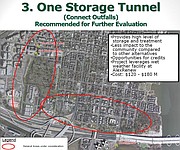Alexandria experiences between 30 to 40 sewer overflows every year. The objective of the Combined Sewer System Long Term Control Plan, presented to the City Council at the May 26 meeting, is to reduce that to four or less. The plan includes an 80-99 percent reduction in combined sewer discharges from Hooffs Run and Royal Street.
The Department of Transportation and Environmental Services laid out a series of nine potential plans and recommendations for fixing Alexandria’s sewer system. The ideas were separated into proposals that were not recommended and three that that could be recommended for further evaluation. These primary strategies would involve creating separate storage tunnels for Hooffs Run and Royal Street, creating a storage tunnel at Hooffs Run and a larger storage tank at the foot of Royal Street near Jones Point Park, or creating one large, connected storage tunnel between the two sites.
The cost of the three primary strategies range from $100 million to $180 million. These options all store water to feed into the Alexandria Renew water treatment facility.
Yon Lambert, director of Transportation and Environmental Services, said the three recommended proposals were chosen based partially on their cost effectiveness, but also on their limited impact to the community.
When City Councilman Paul Smedberg expressed concerns about digging up parts of the street to repair sections of the sewer, Bill Skrabak, the deputy director of Infrastructure and Environment, explained that the Department of Transportation and Environmental Services would use a fiberglass tube to reline the sewers. As the fiberglass runs along the inside of the pipes it hardens and forms a second layer. Skrabak said the fiberglass relining is good for over 30 years, comparable to any newly installed pipeline.
“You don’t have to dig up the whole street, you reline it with an impregnated fiberglass sock and you heat it up and it hardens inside the existing sewers,” said Skrabak. “We’ve done it in several places with some fairly large infrastructure.”
Skrabak said that fairly drastic measures, like separating the currently combined city sewer system into smaller segments, were considered by the Department of Transportation and Environmental Services, but the cost and disruption to the community did not merit the project’s minor impact on sewer overflows.
Green Infrastructure was recommended as a complementary strategy but not as a primary one. Skrabak said the feasibility of trying to implement the amount of green space required to impact the sewer system, even at an optimistic level, only resulted in a 30 percent reduction in sewer discharges. The green infrastructure plan would also require a reduction of parking availability in Old Town.
City Councilman Justin Wilson expressed concerns that the presentation made it seem as though the green infrastructure plan was being dismissed.
“It looks like we’re not doing that, based on the chart, but I wanted to make sure that option was still in the mix,” said Wilson. “The story of this whole thing is going to be a variety of different strategies we piece together.”
Skrabak agreed, emphasizing that the final plan will likely be a combination of various proposed solutions.
On June 18, the Department of Transportation and Environmental Services will host a public information and feedback meeting at 7 p.m. in Chet and Sabra Avery Conference Room in City Hall. The meeting will focus on the progress of the plan and allow residents to ask questions and provide feedback. According to Skrabak, after the public information meeting, the plan will move into feasibility studies and cost analysis. Formal adoption of a long-term sewer control plan is scheduled for May or June of 2016.



